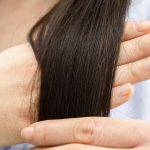
Ways to Protect Hair Ends
Daily crushing can wear down the hair cuticle, which is the protective outer layer of the hair strand. When the cuticle is damaged, the inner layer of the hair is exposed, weakening, dehydrated and damaged, leaving the ends of the hair vulnerable. When it comes to damaging the hair’s structure, it’s probably not as quick as untouching properly. This includes everything from misuse of tools when hair is wet to not ensuring the hair has enough moisture during the styling process.

Match often
No matter how well you care for it, brushing and washing your hair every day will wear out your hair and cannot completely prevent split ends. Inevitably, there was a need to cut back to control the split. However, with proper care, you can extend your cutting appointment every 8-12 weeks or so to protect hair ends. Hair is very silk-like in that it is firm and brittle. Therefore, it is important to be very soft when styling. One way to do this is to avoid brushing or using a wide comb at all times.
Gently dry your hair
Wet hair is fragile and easily damaged. Therefore, to prevent split ends, please handle it with the utmost care. Ruffling your hair vigorously with a towel can cause hair to become tangled and twisted in unnatural directions, causing breakage and split ends. You can fill your edges with any hairstyle. But what I have to say is that if you do it before twisting or braiding, this tends to be most effective.

Protect your hair from the elements
Environmental factors such as coldness to the hair. Long-term exposure to hot sun can damage hair. To stop split ends and increase the likelihood of split ends, you can use hair protein. The protein in hair is not in hand and helps to correct problems prior to the hair protein treatment. You can beat a few raw eggs to make your own. Use a soft cotton towel. This is because it is gentle on the hair.